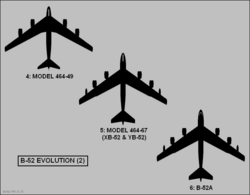A | B | C | D | E | F | G | H | CH | I | J | K | L | M | N | O | P | Q | R | S | T | U | V | W | X | Y | Z | 0 | 1 | 2 | 3 | 4 | 5 | 6 | 7 | 8 | 9
| B-52 Stratofortress | |
|---|---|
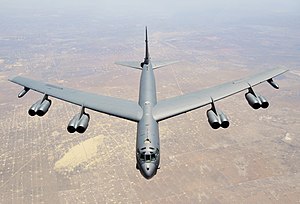
| |
| A B-52H from Barksdale AFB flying over Texas | |
| Role | Strategic bomber |
| National origin | United States |
| Manufacturer | Boeing |
| First flight | 15 April 1952 |
| Introduction | February 1955 |
| Status | In service |
| Primary users | United States Air Force NASA (historical) |
| Produced | 1952–1962 |
| Number built | 744[1] |
The Boeing B-52 Stratofortress is an American long-range, subsonic, jet-powered strategic bomber. The B-52 was designed and built by Boeing, which has continued to provide support and upgrades. It has been operated by the United States Air Force (USAF) since the 1950s, and NASA for over 40 years. The bomber can carry up to 70,000 pounds (32,000 kg) of weapons[2] and has a typical combat range of around 8,800 miles (14,200 km) without aerial refueling.[3]
Beginning with the successful contract bid in June 1946, the B-52 design evolved from a straight wing aircraft powered by six turboprop engines to the final prototype YB-52 with eight turbojet engines and swept wings. The B-52 took its maiden flight in April 1952. The B-52 has been in service with the USAF since 1955, and NASA from 1959 to 2007.[4] Built to carry nuclear weapons for Cold War–era deterrence missions, the B-52 Stratofortress replaced the Convair B-36 Peacemaker.
Superior performance at high subsonic speeds and relatively low operating costs have kept them in service despite the development of more advanced strategic bombers, such as the Mach 2+ Convair B-58 Hustler, the canceled Mach 3 North American XB-70 Valkyrie, the variable-geometry Rockwell B-1 Lancer, and the stealth Northrop Grumman B-2 Spirit. A veteran of several wars, the B-52 has dropped only conventional munitions in combat.
The B-52's official name Stratofortress is rarely used; informally, the aircraft has become commonly referred to as the BUFF (Big Ugly Fat Fucker/Fella).[5][6][7][Note 1] There are 72 aircraft in inventory as of 2022[update];[9] 58 operated by active forces (2nd Bomb Wing and 5th Bomb Wing), 18 by reserve forces (307th Bomb Wing), and about 12 in long-term storage at the Davis-Monthan AFB Boneyard.[2][3][10][11][12] The bombers flew under the Strategic Air Command (SAC) until it was disestablished in 1992 and its aircraft absorbed into the Air Combat Command (ACC); in 2010, all B-52 Stratofortresses were transferred from the ACC to the new Air Force Global Strike Command (AFGSC). The B-52 completed 60 years of continuous service with its original operator in 2015. After being upgraded between 2013 and 2015, the last airplanes are expected to serve into the 2050s.
Development
Origins
On 23 November 1945, Air Materiel Command (AMC) issued desired performance characteristics for a new strategic bomber "capable of carrying out the strategic mission without dependence upon advanced and intermediate bases controlled by other countries".[14] The aircraft was to have a crew of five or more turret gunners, and a six-man relief crew. It was required to cruise at 300 miles per hour (260 kn; 480 km/h) at 34,000 feet (10,000 m) with a combat radius of 5,000 miles (4,300 nmi; 8,000 km). The armament was to consist of an unspecified number of 20 mm cannons and 10,000 pounds (4,500 kg) of bombs.[15] On 13 February 1946, the USAF issued bid invitations for these specifications, with Boeing, Consolidated Aircraft, and Glenn L. Martin Company submitting proposals.[15]
On 5 June 1946, Boeing's Model 462, a straight-wing aircraft powered by six Wright T35 turboprops with a gross weight of 360,000 pounds (160,000 kg) and a combat radius of 3,110 miles (2,700 nmi; 5,010 km), was declared the winner.[16] On 28 June 1946, Boeing was issued a letter of contract for US$1.7 million to build a full-scale mockup of the new XB-52 and do preliminary engineering and testing.[17] However, by October 1946, the USAF began to express concern about the sheer size of the new aircraft and its inability to meet the specified design requirements.[18] In response, Boeing produced the Model 464, a smaller four-engine version with a 230,000-pound (100,000 kg) gross weight, which was briefly deemed acceptable.[19]
Subsequently, in November 1946, the Deputy Chief of Air Staff for Research and Development, General Curtis LeMay, expressed the desire for a cruising speed of 400 miles per hour (350 kn; 640 km/h), to which Boeing responded with a 300,000-pound (140,000 kg) aircraft.[20] In December 1946, Boeing was asked to change their design to a four-engine bomber with a top speed of 400 miles per hour (350 kn; 640 km/h), range of 12,000 miles (10,000 nmi; 19,000 km), and the ability to carry a nuclear weapon; in total, the aircraft could weigh up to 480,000 pounds (220,000 kg).[21] Boeing responded with two models powered by T35 turboprops. The Model 464-16 was a "nuclear only" bomber with a 10,000-pound (4,500 kg) payload, while the Model 464-17 was a general purpose bomber with a 9,000-pound (4,100 kg) payload.[21] Due to the cost associated with purchasing two specialized aircraft, the USAF selected Model 464-17 with the understanding that it could be adapted for nuclear strikes.[22]
In June 1947, the military requirements were updated and the Model 464-17 met all of them except for the range.[23] It was becoming obvious to the USAF that, even with the updated performance, the XB-52 would be obsolete by the time it entered production and would offer little improvement over the Convair B-36 Peacemaker; as a result, the entire project was postponed for six months.[24] During this time, Boeing continued to perfect the design, which resulted in the Model 464-29 with a top speed of 455 miles per hour (395 kn; 732 km/h) and a 5,000-mile (8,000 km) range.[25] In September 1947, the Heavy Bombardment Committee was convened to ascertain performance requirements for a nuclear bomber. Formalized on 8 December 1947, these requirements called for a top speed of 500 miles per hour (430 kn; 800 km/h) and an 8,000-mile (7,000 nmi; 13,000 km) range, far beyond the capabilities of the 464-29.[26]
The outright cancellation of the Boeing contract on 11 December 1947 was staved off by a plea from its president William McPherson Allen to the Secretary of the Air Force Stuart Symington.[27] Allen reasoned that the design was capable of being adapted to new aviation technology and more stringent requirements.[28] In January 1948, Boeing was instructed to thoroughly explore recent technological innovations, including aerial refueling and the flying wing.[29] Noting stability and control problems Northrop Corporation was experiencing with their YB-35 and YB-49 flying wing bombers, Boeing insisted on a conventional aircraft, and in April 1948 presented a US$30 million (US$380 million today[30]) proposal for design, construction, and testing of two Model 464-35 prototypes.[31] Further revisions during 1948 resulted in an aircraft with a top speed of 513 miles per hour (446 kn; 826 km/h) at 35,000 feet (11,000 m), a range of 6,909 miles (6,004 nmi; 11,119 km), and a 280,000-pound (130,000 kg) gross weight, which included 10,000 pounds (4,500 kg) of bombs and 19,875 US gallons (75,240 L) of fuel.[32]
Design effort


In May 1948, Air Materiel Command asked Boeing to incorporate the previously discarded jet engine, with improvements in fuel efficiency, into the design.[33] That resulted in the development of yet another revision—in July 1948, Model 464-40 substituted Westinghouse J40 turbojets for the turboprops.[34] The USAF project officer who reviewed the Model 464-40 was favorably impressed, especially since he had already been thinking along similar lines. Nevertheless, the government was concerned about the high fuel consumption rate of the jet engines of the day, and directed Boeing to use the turboprop-powered Model 464-35 as the basis for the XB-52. Although he agreed that turbojet propulsion was the future, General Howard A. Craig, Deputy Chief of Staff for Materiel, was not very enthusiastic about a jet-powered B-52 since he felt that the jet engine had not yet progressed sufficiently to permit skipping an intermediate turboprop stage. However, Boeing was encouraged to continue turbojet studies even without any expected commitment to jet propulsion.[35][36]
On Thursday, 21 October 1948, Boeing engineers George S. Schairer, Art Carlsen, and Vaughn Blumenthal presented the design of a four-engine turboprop bomber to the chief of bomber development, Colonel Pete Warden. Warden was disappointed by the projected aircraft and asked if the Boeing team could produce a proposal for a four-engine turbojet bomber. Joined by Ed Wells, Boeing's vice president of engineering, the engineers worked that night in The Hotel Van Cleve in Dayton, Ohio, redesigning Boeing's proposal as a four-engine turbojet bomber. On Friday, Colonel Warden looked over the information and asked for a better design. Returning to the hotel, the Boeing team was joined by Bob Withington and Maynard Pennell, two top Boeing engineers who were in town on other business.[37]
By late Friday night, they had laid out what was an essentially new airplane. The new design (464-49) built upon the basic layout of the B-47 Stratojet with 35-degree swept wings, eight engines paired in four underwing pods, and bicycle landing gear with wingtip outrigger wheels.[38] A notable feature was the ability to pivot both fore and aft main landing gear up to 20° from the aircraft centerline to increase safety during crosswind landings (allowing the aircraft to "crab" or roll with a sideways slip angle down the runway).[39] After a trip to a hobby shop for supplies, Schairer set to work building a model. The rest of the team focused on weight and performance data. Wells, who was also a skilled artist, completed the aircraft drawings. On Sunday, a stenographer was hired to type a clean copy of the proposal. On Monday, Schairer presented Colonel Warden with a neatly bound 33-page proposal and a 14-inch (36 cm) scale model.[40][41] The aircraft was projected to exceed all design specifications.[42]

Although the full-size mock-up inspection in April 1949 was generally favorable, range again became a concern since the J40s and early model J57s had excessive fuel consumption.[43] Despite talk of another revision of specifications or even a full design competition among aircraft manufacturers, General LeMay, now in charge of Strategic Air Command, insisted that performance should not be compromised due to delays in engine development.[44] In a final attempt to increase range, Boeing created the larger 464-67, stating that once in production, the range could be further increased in subsequent modifications.[45] Following several direct interventions by LeMay,[46] Boeing was awarded a production contract for thirteen B-52As and seventeen detachable reconnaissance pods on 14 February 1951.[47] The last major design change—also at General LeMay's insistence—was a switch from the B-47 style tandem seating to a more conventional side-by-side cockpit, which increased the effectiveness of the copilot and reduced crew fatigue.[48] Both XB-52 prototypes featured the original tandem seating arrangement with a framed bubble-type canopy (see above images).[49]
Tex Johnston noted, "The B-52, like the B-47, utilized a flexible wing. I saw the wingtip of the B-52 static test airplane travel 32 feet (9.8 m), from the negative 1-G load position to the positive 4-G load position." The flexible structure allowed "...the wing to flex during gust and maneuvering loads, thus relieving high-stress areas and providing a smoother ride." During a 3.5-G pullup, "The wingtips appeared about 35 degrees above level flight position."[50]
Pre-production and production
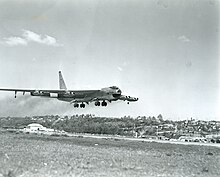
During ground testing on 29 November 1951, the XB-52's pneumatic system failed during a full-pressure test; the resulting explosion severely damaged the trailing edge of the wing, necessitating considerable repairs. The YB-52, the second XB-52 modified with more operational equipment, first flew on 15 April 1952 with "Tex" Johnston as the pilot.[51][52] A 2-hour, 21-minute proving flight from Boeing Field, near Seattle, Washington, to Larson Air Force Base was undertaken with Boeing test pilot Johnston and USAF Lieutenant Colonel Guy M. Townsend.[53] The XB-52 followed on 2 October 1952.[54] The thorough development,[Note 2] including 670 days in the wind tunnel and 130 days of aerodynamic and aeroelastic testing, paid off with smooth flight testing. Encouraged, the USAF increased its order to 282 B-52s.[56]
| Fiscal year |
B-52 model | Total | ||||||||
|---|---|---|---|---|---|---|---|---|---|---|
| A [57] |
B [58] |
C [59] |
D [60] |
E [61] |
F [62] |
G [63] |
H [64] |
Annual | Cumulative | |
| 1954 | 3 | 3 | 3 | |||||||
| 1955 | 13 | 13 | 16 | |||||||
| 1956 | 35 | 5 | 1 | 41 | 57 | |||||
| 1957 | 2 | 30 | 92 | 124 | 181 | |||||
| 1958 | 77 | 100 | 10 | 187 | 368 | |||||
| 1959 | 79 | 50 | 129 | 497 | ||||||
| 1960 | 106 | 106 | 603 | |||||||
| 1961 | 37 | 20 | 57 | 660 | ||||||
| 1962 | 68 | 68 | 728 | |||||||
| 1963 | 14 | 14 | 742 | |||||||
| Total | 3 | 50 | 35 | 170 | 100 | 89 | 193 | 102 | 742 | 742 |
Only three of the 13 B-52As ordered were built.[65] All were returned to Boeing and used in their test program.[57] On 9 June 1952, the February 1951 contract was updated to order the aircraft under new specifications. The final 10, the first aircraft to enter active service, were completed as B-52Bs.[57] At the roll-out ceremony on 18 March 1954, Air Force Chief of Staff General Nathan Twining said:
The long rifle was the great weapon of its day. ... today this B-52 is the long rifle of the air age.[66]
The B-52B was followed by progressively improved bomber and reconnaissance variants, culminating in the B-52G and turbofan B-52H. To allow rapid delivery, production lines were set up both at its main Seattle factory and at Boeing's Wichita facility. More than 5,000 companies were involved in the huge production effort, with 41% of the airframe being built by subcontractors.[67] The prototypes and all B-52A, B and C models (90 aircraft)[68] were built at Seattle. Testing of aircraft built in Seattle caused problems due to jet noise, which led to the establishment of curfews for engine tests. Aircraft were ferried 150 miles (240 km) east on their maiden flights to Larson Air Force Base near Moses Lake, where they were fully tested.[69]
As production of the B-47 came to an end, the Wichita factory was phased in for B-52D production, with Seattle responsible for 101 D-models and Wichita 69.[70] Both plants continued to build the B-52E, with 42 built at Seattle and 58 at Wichita,[71] and the B-52F (44 from Seattle and 45 from Wichita).[72] For the B-52G, Boeing decided in 1957 to transfer all production to Wichita, which freed up Seattle for other tasks, in particular, the production of airliners.[73] Production ended in 1962 with the B-52H, with 742 aircraft built, plus the original two prototypes.[74]
Upgrades
A proposed variant of the B-52H was the EB-52H, which would have consisted of 16 modified and augmented B-52H airframes with additional electronic jamming capabilities.[75][76] This variant would have restored USAF airborne jamming capability that it lost on retiring the EF-111 Raven. The program was canceled in 2005 following the removal of funds for the stand-off jammer. The program was revived in 2007 and cut again in early 2009.[77]
In July 2013, the USAF began a fleet-wide technological upgrade of its B-52 bombers called Combat Network Communications Technology (CONECT) to modernize electronics, communications technology, computing, and avionics on the flight deck. CONECT upgrades include software and hardware such as new computer servers, modems, radios, data-links, receivers, and digital workstations for the crew. One update is the AN/ARC-210 Warrior beyond-line-of-sight software programmable radio able to transmit voice, data, and information in-flight between B-52s and ground command and control centers, allowing the transmission and reception of data with updated intelligence, mapping, and targeting information; previous in-flight target changes required copying down coordinates. The ARC-210 allows machine-to-machine transfer of data, useful on long-endurance missions where targets may have moved before the arrival of the B-52. The aircraft will be able to receive information through Link-16. CONECT upgrades will cost US$1.1 billion overall and take several years. Funding has been secured for 30 B-52s; the USAF hopes for 10 CONECT upgrades per year, but the rate has yet to be decided.[78][79]
Weapons upgrades include the 1760 Internal Weapons Bay Upgrade (IWBU), which gives a 66 percent increase in weapons payload using a digital interface (MIL-STD-1760) and rotary launcher. IWBU is expected to cost roughly US$313 million.[78] The 1760 IWBU will allow the B-52 to carry eight[80] JDAM 2,000-pound (910 kg) bombs, AGM-158B JASSM-ER cruise missile and the ADM-160C MALD-J decoy missiles internally. All 1760 IWBUs should be operational by October 2017. Two bombers will have the ability to carry 40 weapons in place of the 36 that three B-52s can carry.[81] The 1760 IWBU allows precision-guided missiles or bombs to be deployed from inside the weapons bay; the previous aircraft carried these munitions externally on the wing hardpoints. This increases the number of guided weapons (Joint Direct Attack Munition or JDAM) a B-52 can carry and reduces the need for guided bombs to be carried on the wings. The first phase will allow a B-52 to carry twenty-four GBU-38 500-pound guided bombs or twenty GBU-31 2,000-pound bombs, with later phases accommodating the JASSM and MALD family of missiles.[82] In addition to carrying more smart bombs, moving them internally from the wings reduces drag and achieves a 15 percent reduction in fuel consumption.[83]
The US Air Force Research Lab is investigating defensive laser weapons for the B-52.[84]
The B-52 is due to receive a range of upgrades alongside a planned engine retrofit. These upgrades aim to modernize the sensors and displays of the B-52. They include the new APG-79B4 Active electronically scanned array radar, replacing older mechanically scanned arrays, the streamlining of the nose and deletion of blisters housing the forward-looking infrared/electro-optical viewing system. In October 2022 Boeing released new images of what the upgrade would look like.[85][86] The upgrades will also include improved communication systems, new pylons, new cockpit displays and the deletion of one crew station. The changes will carry the designation B-52J.[86][87]
Design
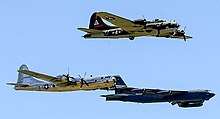
Overview
The B-52 shared many technological similarities with the preceding B-47 Stratojet strategic bomber. The two aircraft used the same basic design, such as swept wings and podded jet engines,[88] and the cabin included the crew ejection systems.[89] On the B-52D, the pilots and electronic countermeasures (ECM) operator ejected upwards, while the lower deck crew ejected downwards; until the B-52G, the gunner had to jettison the tail gun to bail out.[90] The tail gunner in early model B-52s was located in the traditional location in the tail of the plane, with both visual and radar gun laying systems; in later models, the gunner was moved to the front of the fuselage, with gun laying carried out by radar alone, much like the B-58 Hustler's tail gun system.[91]
Structural fatigue was accelerated by at least a factor of eight in a low-altitude flight profile over that of high-altitude flying, requiring costly repairs to extend service life. In the early 1960s, the three-phase High Stress program was launched to counter structural fatigue, enrolling aircraft at 2,000 flying hours.[92] Follow-up programs were conducted, such as a 2,000-hour service life extension to select airframes in 1966–1968, and the extensive Pacer Plank reskinning, completed in 1977.[93] The wet wing introduced on G and H models was even more susceptible to fatigue, experiencing 60% more stress during a flight than the old wing. The wings were modified by 1964 under ECP 1050.[94] This was followed by a fuselage skin and longeron replacement (ECP 1185) in 1966, and the B-52 Stability Augmentation and Flight Control program (ECP 1195) in 1967.[94] Fuel leaks due to deteriorating Marman clamps continued to plague all variants of the B-52. To this end, all aircraft variants were subjected to Blue Band (1957), Hard Shell (1958), and finally QuickClip (1958) programs. The latter fitted safety straps that prevented catastrophic loss of fuel in case of clamp failure.[95] The B-52's service ceiling is officially listed as 50,000 feet (15,000 m), but operational experience shows this is difficult to reach when fully laden with bombs. According to one source: "The optimal altitude for a combat mission was around 43,000 feet (13,000 m), because to exceed that height would rapidly degrade the plane's range."[96]

In September 2006, the B-52 became one of the first US military aircraft to fly using alternative fuel. It took off from Edwards Air Force Base with a 50/50 blend of Fischer–Tropsch process (FT) synthetic fuel and conventional JP-8 jet fuel, which burned in two of the eight engines. On 15 December 2006, a B-52 took off from Edwards with the synthetic fuel powering all eight engines, the first time a USAF aircraft was entirely powered by the blend. The seven-hour flight was considered a success. This program is part of the Department of Defense Assured Fuel Initiative, which aimed to reduce crude oil usage and obtain half of its aviation fuel from alternative sources by 2016.[98] On 8 August 2007, Air Force Secretary Michael Wynne certified the B-52H as fully approved to use the FT blend.[99]
Flight controls
Because of the B-52's mission parameters, only modest maneuvers would be required with no need for spin recovery. The aircraft has a relatively small, narrow chord rudder, giving it limited yaw control authority. Originally an all-moving vertical stabilizer was to be used but was abandoned because of doubts about hydraulic actuator reliability.[100] Because the aircraft has eight engines, asymmetrical thrust due to the loss of an engine in flight would be minimal and correctable with the narrow rudder. To assist with crosswind takeoffs and landings the main landing gear can be pivoted 20 degrees to either side from neutral.[101] The crew would preset the yaw adjustable crosswind landing gear according to wind observations made on the ground.
Like the rudder, the elevator is also very narrow chord and the B-52 suffers from limited elevator control authority. For long-term pitch trim and airspeed changes the aircraft uses a stabilator (or all-moving tail) with the elevator used for small adjustments within a stabilizer setting. The stabilizer is adjustable through 13 degrees of movement (nine up, four down) and is crucial to operations during takeoff and landing due to large pitch changes induced by flap application.[102]
B-52s prior to the G models had very small ailerons with a short span that was approximately equal to their chord. These "feeler ailerons" were used to provide feedback forces to the pilot's control yoke and to fine-tune the roll axes during delicate maneuvers such as aerial refueling. Due to twisting of the thin main wing, conventional outboard flap-type ailerons would lose authority and therefore could not be used. In other words, aileron activation would cause the wing to twist, undermining roll control. Six spoilerons on each wing are responsible for the majority of roll control. The late B-52G models eliminated the ailerons altogether and added an extra spoileron to each wing.[100] Partly because of the lack of ailerons, the B-52G and H models were more susceptible to Dutch roll.[102]
Avionics
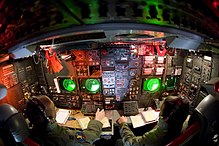
Ongoing problems with avionics systems were addressed in the Jolly Well program, completed in 1964, which improved components of the AN/ASQ-38 bombing navigational computer and the terrain computer. The MADREC (Malfunction Detection and Recording) upgrade fitted to most aircraft by 1965 could detect failures in avionics and weapons computer systems and was essential in monitoring the AGM-28 Hound Dog missiles. The electronic countermeasures capability of the B-52 was expanded with Rivet Rambler (1971) and Rivet Ace (1973).[103]
To improve operations at low altitudes, the AN/ASQ-151 Electro-Optical Viewing System (EVS), which consisted of a low light level television (LLLTV) and a forward looking infrared (FLIR) system mounted in blisters under the noses of B-52Gs and Hs between 1972 and 1976.[104] The navigational capabilities of the B-52 were later augmented with the addition of GPS in the 1980s.[105] The IBM AP-101, also used on the Rockwell B-1 Lancer bomber and the Space Shuttle, was the B-52's main computer.[106]
In 2007, the LITENING targeting pod was fitted, which increased the effectiveness of the aircraft in the attack of ground targets with a variety of standoff weapons, using laser guidance, a high-resolution forward-looking infrared sensor (FLIR), and a CCD camera used to obtain target imagery.[107] LITENING pods have been fitted to a wide variety of other US aircraft, such as the McDonnell Douglas F/A-18 Hornet, the General Dynamics F-16 Fighting Falcon and the McDonnell Douglas AV-8B Harrier II.[108]
Armament

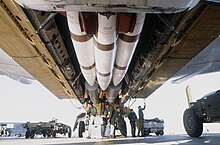
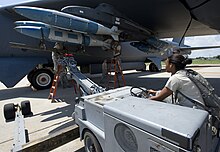
The ability to carry up to 20 AGM-69 SRAM nuclear missiles was added to G and H models, starting in 1971.[109] To further improve its offensive ability, air-launched cruise missiles (ALCMs) were fitted.[110] After testing of both the USAF-backed Boeing AGM-86 Air Launched Cruise Missile and the Navy-backed General Dynamics AGM-109 Tomahawk, the AGM-86B was selected for operation by the B-52 (and ultimately by the B-1 Lancer).[111] A total of 194 B-52Gs and Hs were modified to carry AGM-86s, carrying 12 missiles on underwing pylons, with 82 B-52Hs further modified to carry another eight missiles on a rotary launcher fitted in the bomb bay. To conform with SALT II Treaty requirements that cruise missile-capable aircraft be readily identifiable by reconnaissance satellites, the cruise missile-armed B-52Gs were modified with a distinctive wing root fairing. As all B-52Hs were assumed modified, no visual modification of these aircraft was required.[112] In 1990, the stealthy AGM-129 ACM cruise missile entered service; although intended to replace the AGM-86, the high cost and the Cold War's end led to only 450 being produced; unlike the AGM-86, no conventional, non-nuclear version was built.[113] The B-52 was to have been modified to utilize Northrop Grumman's AGM-137 TSSAM weapon; however, the missile was canceled due to development costs.[114]
Those B-52Gs not converted as cruise missile carriers underwent a series of modifications to improve conventional bombing. They were fitted with a new Integrated Conventional Stores Management System (ICSMS) and new underwing pylons that could hold larger bombs or other stores than the external pylons could. Thirty B-52Gs were further modified to carry up to 12 AGM-84 Harpoon anti-ship missiles each, while 12 B-52Gs were fitted to carry the AGM-142 Have Nap stand-off air-to-ground missile.[115] When the B-52G was retired in 1994, an urgent scheme was launched to restore an interim Harpoon and Have Nap capability,[Note 3] the four aircraft being modified to carry Harpoon and four to carry Have Nap under the Rapid Eight program.[117]
The Conventional Enhancement Modification (CEM) program gave the B-52H a more comprehensive conventional weapons capability, adding the modified underwing weapon pylons used by conventional-armed B-52Gs, Harpoon and Have Nap, and the capability to carry new-generation weapons including the Joint Direct Attack Munition (JDAM) and Wind Corrected Munitions Dispenser guided bombs, the AGM-154 glide bomb and the AGM-158 JASSM missile. The CEM program also introduced new radios, integrated Global Positioning System into the aircraft's navigation system, and replaced the under-nose FLIR with a more modern unit. Forty-seven B-52Hs were modified under the CEM program by 1996, with 19 more by the end of 1999.[118]
By around 2010, U.S. Strategic Command stopped assigning B61 and B83 nuclear gravity bombs to B-52, and later listed only the B-2 as tasked with delivering strategic nuclear bombs in budget requests. Nuclear gravity bombs were removed from the B-52's capabilities because it is no longer considered survivable enough to penetrate modern air defenses, instead relying on nuclear cruise missiles and focusing on expanding its conventional strike role.[119] The 2019 "Safety Rules for U.S. Strategic Bomber Aircraft" manual subsequently confirmed the removal of B61-7 and B83-1 gravity bombs from the B-52H's approved weapons configuration.[120]
Starting in 2016, Boeing is to upgrade the internal rotary launchers to the MIL-STD-1760 interface to enable the internal carriage of smart bombs, which previously could be carried only on the wings.[121]
While the B-1 Lancer has a larger theoretical maximum payload of 75,000 pounds (34,000 kg) compared to the B-52's 70,000 pounds (32,000 kg), the bombers are rarely able to carry their full loads. The most the B-52 carries is a full load of AGM-86Bs totaling 62,660 pounds (28,420 kg). The B-1 has the internal weapons bay space to carry more GBU-31 JDAMs and JASSMs, but the B-52 upgraded with the conventional rotary launcher can carry more of other JDAM variants.[122]
The AGM-183A Air-Launched Rapid Response (ARRW) hypersonic missile and the future Long Range Stand Off (LRSO) nuclear-armed air-launched cruise missile will join the B-52 inventory in the future.[123]
Engines

The eight engines of the B-52 are paired in pods and suspended by four pylons beneath and forward of the wings' leading edge. The careful arrangement of the pylons also allowed them to work as wing fences and delay the onset of stall. The first two prototypes, XB-52 and YB-52, were both powered by experimental Pratt & Whitney YJ57-P-3 turbojet engines with 8,700 pounds-force (39 kN) of static thrust each.[102]
The B-52A models were equipped with Pratt & Whitney J57-P-1W turbojets, providing a dry thrust of 10,000 pounds-force (44 kN) which could be increased for short periods to 11,000 pounds-force (49 kN) with water injection. The water was carried in a 360 US gallons (1,400 L) tank in the rear fuselage.[124]
B-52B, C, D and E models were equipped with Pratt & Whitney J57-P-29W, J57-P-29WA, or J57-P-19W series engines all rated at 10,500 lbf (47 kN). The B-52F and G models were powered by Pratt & Whitney J57-P-43WB turbojets, each rated at 13,750 pounds-force (61.2 kN) static thrust with water injection.
On 9 May 1961, the B-52H began to be delivered to the USAF with cleaner burning and quieter Pratt & Whitney TF33-P-3 turbofans with a maximum thrust of 17,100 pounds-force (76 kN).[102]
Engine retrofit
In a study for the USAF in the mid-1970s, Boeing investigated replacing the engines, changing to a new wing, and other improvements to upgrade B-52G/H aircraft as an alternative to the B-1A, then in development.[125]
In 1996, Rolls-Royce and Boeing jointly proposed fitting each B-52 with four leased Rolls-Royce RB211 engines. This would have involved replacing the eight Pratt & Whitney TF33 engines (total thrust 136,000 lbf (600 kN)) with four RB211-535E4 engines (total thrust 172,400 lbf (767 kN)), which would increase range and reduce fuel consumption.[126][127] However, a USAF analysis in 1997 concluded that Boeing's estimated savings of US$4.7 billion would not be realized and that reengining would instead cost US$1.3 billion more than keeping the existing engines, citing significant up-front procurement and re-tooling expenditure.[128]
The USAF's 1997 rejection of reengining was subsequently disputed in a Defense Science Board (DSB) report in 2003. The DSB urged the USAF to re-engine the aircraft without delay,[129] saying doing so would not only create significant cost savings but reduce greenhouse gas emissions and increase aircraft range and endurance; these conclusions were in line with the conclusions of a separate Congress-funded study conducted in 2003. Criticizing the USAF cost analysis, the DSB found that among other things, the USAF failed to account for the cost of aerial refueling; the DSB estimated that aerial refueling cost $17.50 per US gallon ($4.62/L), whereas the USAF had failed to account for the cost of delivering the fuel and so had only priced fuel at $1.20 per US gallon ($0.32/L).[130]
On 23 April 2020, the USAF released its request for proposals for 608 commercial engines plus spares and support equipment, with the plan to award the contract in May 2021.[131] This Commercial Engine Reengining Program (CERP) saw General Electric propose its CF34-10 and Passport turbofans, Pratt & Whitney its PW800, and the Rolls-Royce BR725 to be designated F130.[131] On 24 September 2021, the USAF selected the Rolls-Royce F130 as the winner and announced plans to purchase 650 engines (608 direct replacements and 42 spares), for US$2.6 billion.[132][133]
Unlike the previous re-engine proposal which also involved reducing the number of engines from eight to four, the F130 re-engine program maintains eight engines on the B-52. Although four-engine operation would be more efficient, retrofitting the airframe to operate with only four engines would involve additional changes to the aircraft's systems and control surfaces (particularly the rudder), thereby increasing the time, cost, and complexity of the project.[134] B-52Hs upgraded with Rolls Royce F130 engines will be redesignated as "B-52Js".[133]
Costs
| Inflation year | X/YB-52 | B-52A | B-52B | B-52C | B-52D | B-52E | B-52F | B-52G | B-52H | |
|---|---|---|---|---|---|---|---|---|---|---|
| Unit R&D cost | 1955 | 100 M | ||||||||
| Current | 1,137 M | |||||||||
| Airframe | 1955 | 26.433 M | 11.328 M | 5.359 M | 4.654 M | 3.700 M | 3.772 M | 5.352 M | 6.076 M | |
| Engines | 1955 | 2.848 M | 2.547 M | 1.513 M | 1.291 M | 1.257 M | 1.787 M | 1.428 M | 1.640 M
Zdroj:https://en.wikipedia.org?pojem=Boeing_B-52H >Text je dostupný pod licencí Creative Commons Uveďte autora – Zachovejte licenci, případně za dalších podmínek. Podrobnosti naleznete na stránce Podmínky užití. čítajte viac o Boeing_B-52H
Text je dostupný za podmienok Creative
Commons Attribution/Share-Alike License 3.0 Unported; prípadne za ďalších
podmienok. |

